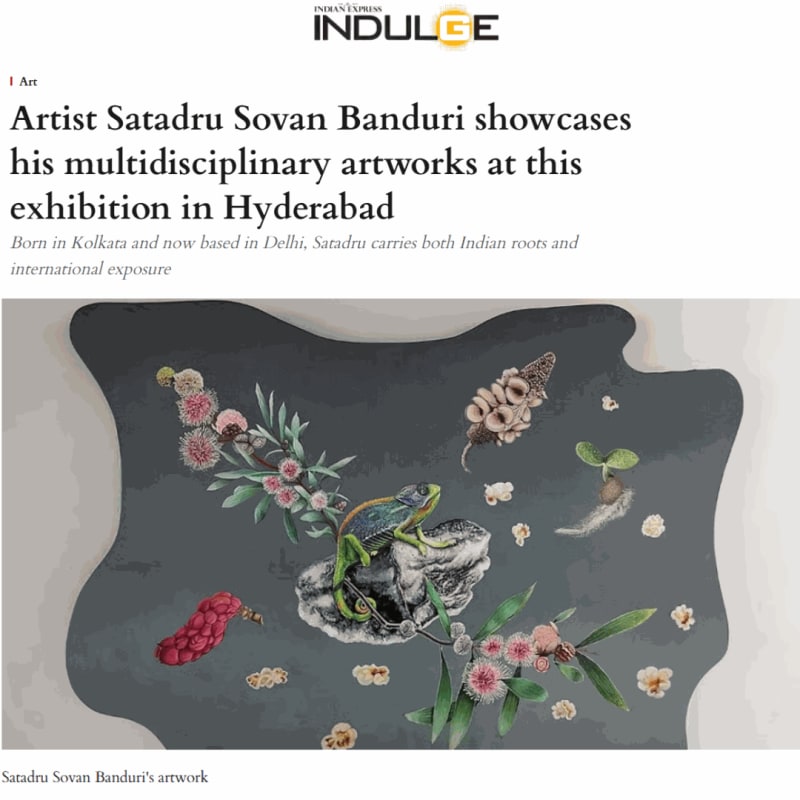Born in Kolkata and now based in Delhi, Satadru carries both Indian roots and international exposure
Climate change today is more than just a conversation starter; it’s a harsh reality affecting not only humans but also flowers, plants, and wildlife. As the most evolved species, we take pride in our advancements, our successes, and our modern lives. Yet, amidst our concrete jungles and self-created bubbles, we often forget a fundamental truth: we’re part of a much larger ecosystem. We don’t exist in isolation; the trees, animals, and the entire natural world are intertwined with our lives, sharing this fragile planet. Bringing this forgotten connection back into focus is artist Satadru Sovan Banduri, whose latest exhibition, Disappearing Echoes of the Isolated, serves as a visual reminder of this delicate coexistence.
Satadru brings his visions to life using a mix of acrylic and gouache on canvas
Born in Kolkata and now based in Delhi, Satadru carries both Indian roots and international exposure. A Shantiniketan alumnus, he began his career as an animation designer before exploring the global art scene and returning to India as a multidisciplinary artist and art teacher. “For me, it’s a whole process when it comes to art,” he shares. “I start by writing, sometimes just a few lines of poetry, then think about how to visualise it. I research, create digital collages, and finally, paint. I don’t like to stay restricted in any manner, so I’ve made it multidisciplinary work.” Satadru brings his visions to life using a mix of acrylic and gouache on canvas.
At the exhibition, Satadru’s paintings reflect on the fragile state of our ecology, highlighting the impact of climate change on animals, birds, and plant life. “I recently read an article that said one species is vanishing every year. Migratory birds are arriving early, confused by weather changes. Flowers are blooming before their time. It’s not a good sign for the ecosystem,” he says. His artworks mirror this chaos, the canvas itself is irregular, intentionally shaped to reflect the growing unpredictability of our environment. Referencing the Himalayas, he notes that while tectonic shifts continue to raise the mountains, global warming is rapidly altering the region. “The map is changing,” he adds. “There’s no shape to my canvas, just like the climate today.”
The artworks speak not just through image but through ecological grief. One of Satadru’s striking paintings features a peacock, India’s national bird, standing still, its head bowed. “Once a regal symbol of beauty, fertility, and freedom, it lowers its head in disorientation. It is no longer dancing, no longer calling,” he says. Surrounded by broken flora and displaced birds, the peacock stands silently on unfamiliar ground, “uprooted, confused, and silenced.”
This painting, along with another depicting seemingly peaceful forest life, deer, antelope, and a lone peacock, is inspired by the Hyderabad University land dispute. Over 400 acres of rich Deccan terrain in Kancha Gachibowli are being cleared for IT development. “At first glance, it looks tranquil,” Satadru notes, “but the silence here is unnatural. Something vital has been unplugged.” His work captures this ecological loss, a quiet mourning for the sanctuary now fading under bulldozers and concrete.
For Satadru, art becomes a medium to channel his grief, concerns, and restless emotions, each canvas a reflection of his inner dialogue with a world in crisis.
Free entry. 11 pm to 7 pm.
On till August 10.
At Kalakriti Art Gallery,
Banjara Hills.


